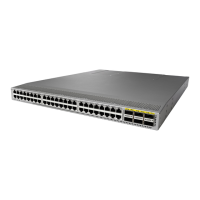Send document comments to nexus3k-docfeedback@cisco.com
9-11
Cisco Nexus 3000 Series NX-OS Unicast Routing Configuration Guide, NX-OS Release5.0(3)U1(1)
Chapter 9 Configuring Layer 3 Virtualization
Configuring VRFs
SUMMARY STEPS
1. configure terminal
2. snmp-server host ip-address [filter_vrf vrf-name] [use-vrf vrf-name]
3. vrf context [vrf-name]
4. ip domain-list domain-name [all-vrfs][use-vrf vrf-name]
5. (Optional) copy running-config startup-config
DETAILED STEPS
This example shows how to send SNMP information for all VRFs to SNMP host 192.0.2.1, reachable on
VRF Red:
switch# configure terminal
switch(config)# snmp-server host 192.0.2.1 for-all-vrfs use-vrf Red
switch(config)# copy running-config startup-config
This example shows how to Filter SNMP information for VRF Blue to SNMP host 192.0.2.12, reachable
on VRF Red:
switch# configure terminal
switch(config)# vrf definition Blue
switch(config-vrf)# snmp-server host 192.0.2.12 use-vrf Red
switch(config)# copy running-config startup-config
Command Purpose
Step 1
configure terminal
Example:
switch# configure terminal
switch(config)#
Enters configuration mode.
Step 2
snmp-server host
ip-address
[filter-vrf
vrf-name
] [use-vrf
vrf-name
]
Example:
switch(config)# snmp-server host
192.0.2.1 use-vrf Red
switch(config-vrf)#
Configures a global SNMP server and configures the
VRF that Cisco NX-OS uses to reach the service Use
the filter-vrf keyword to filter information from the
selected VRF to this server.
Step 3
vrf context
vrf-name
Example:
switch(config)# vrf context Blue
switch(config-vrf)#
Creates a new VRF.
Step 4
ip domain-list
domain-name
[all-vrfs][use-vrf
vrf-name
]
Example:
switch(config-vrf)# ip domain-list List
all-vrfs use-vrf Blue
switch(config-vrf)#
Configures the domain list in the VRF and optionally
configures the VRF that Cisco NX-OS uses to reach
the domain name listed.
Step 5
copy running-config startup-config
Example:
switch(config)# copy running-config
startup-config
(Optional) Saves this configuration change.

